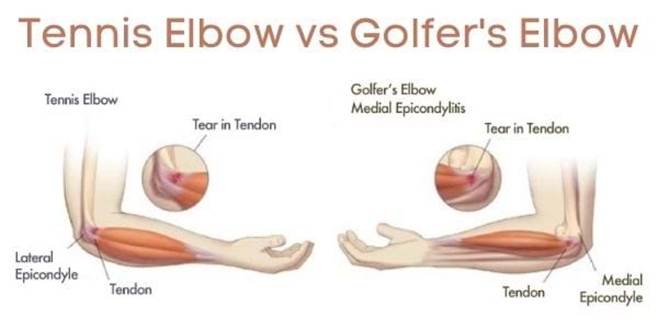Pain in the elbow can significantly impact your daily routine, especially if it affects your grip, lifting ability, or even simple actions like turning a doorknob. Two common culprits behind elbow pain are Tennis Elbow and Golfer’s Elbow. Despite their sporty names, these conditions can affect anyone — not just athletes.
Both involve overuse injuries, but they affect different tendons and occur on opposite sides of the elbow. Let’s explore how they differ in causes, symptoms, and treatment.
What is Tennis Elbow?
Tennis Elbow (lateral epicondylitis) is a condition where the tendons on the outside of the elbow become irritated due to repetitive motions of the wrist and arm. It often affects people who engage in repetitive gripping or lifting, especially with the palm facing down.
Common Causes:
- Repetitive wrist extension
- Racket sports (tennis, badminton)
- Painting or carpentry work
- Prolonged computer mouse use
Symptoms:
- Pain or burning on the outer part of the elbow
- Weak grip strength
- Discomfort worsens with wrist extension or lifting
What is Golfer’s Elbow?
Golfer’s Elbow (medial epicondylitis) affects the tendons on the inner side of the elbow. It’s caused by overuse of the muscles used to flex the wrist and fingers, especially with forceful wrist movements or gripping.
Common Causes:
- Repetitive wrist flexion
- Golf, throwing sports, or weightlifting
- Manual labor (plumbing, construction)
- Frequent lifting of heavy objects
Symptoms:
- Pain or tenderness on the inner side of the elbow
- Stiffness and weakness in the wrist
- Numbness or tingling in the ring and little fingers
Key Differences Between Tennis and Golfer’s Elbow
| Feature | Tennis Elbow | Golfer’s Elbow |
| Affected Area | Outside of the elbow (lateral epicondyle) | Inside of the elbow (medial epicondyle) |
| Movement Trigger | Wrist extension | Wrist flexion |
| Common Occupations | Typists, carpenters, painters | Golfers, plumbers, weightlifters |
| Nerve Involvement | Rarely involved | May involve ulnar nerve (tingling) |
Diagnosis
Diagnosis typically involves a physical exam and patient history. A doctor may check:
- Tenderness over the elbow joint
- Pain during specific wrist movements
- Muscle weakness in the forearm
In more severe or unclear cases, imaging like X-rays or MRI might be used to rule out other issues.
Treatment Options
Conservative Treatments
- Rest and Activity Modification
Reduce repetitive activities that worsen the pain. - Ice Therapy
Apply ice packs for 15–20 minutes several times a day. - Wrist Braces or Elbow Straps
Help offload tension from the affected tendons. - Physical Therapy
Stretching and strengthening exercises to rehabilitate the tendons. - NSAIDs
Over-the-counter pain relievers to manage inflammation.
Advanced Interventions
If symptoms persist:
- Corticosteroid Injections
- Platelet-Rich Plasma (PRP) Therapy
- Surgical Release (in rare, chronic cases)
Prevention Tips
- Warm Up Before Activities
Gentle stretches before sports or repetitive tasks. - Strengthen Forearm Muscles
Incorporate resistance training to support tendon health. - Use Proper Technique
Whether typing, swinging a racket, or lifting — form matters. - Ergonomic Adjustments
Use supportive gear or workstation setups to reduce strain.
Conclusion
While Tennis Elbow and Golfer’s Elbow sound similar, they involve different tendons and occur on opposite sides of the elbow. Recognizing the difference is essential for proper treatment and recovery. With early intervention and consistent care, most people recover without surgery and return to full activity.
If you’re experiencing persistent elbow pain, consult a healthcare professional to get an accurate diagnosis and a tailored treatment plan.
Disclaimer: This content is for informational purposes only and does not substitute professional medical advice. Please consult a doctor for a proper diagnosis and treatment.
